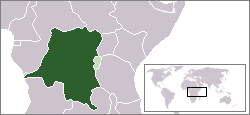|
Belgian Congo. Leopoldville, Congo
Art Deco Plaque
Society for Hydro Electric Power
1930-1950 Art Deco Plaque (Medal) 7.3 x 5.2 centimeters (113.9 grams)
Pedigree / Provenance: Ex Schulman Gallery
Belgian and African overlooking a hydro electric power installation.
You are bidding on the exact item pictured, provided with a Certificate of Authenticity and Lifetime Guarantee of Authenticity.
Kinshasa is the capital and the largest city of the Democratic Republic of the Congo. The city is situated alongside the Congo River.
Once a site of fishing and trading villages, Kinshasa is now a megacity with an estimated population of more than 11 million. It faces Brazzaville, the capital of the neighbouring Republic of the Congo, which can be seen in the distance across the wide Congo River, making them the world’s second-closest pair of capital cities after Rome and Vatican City. The city of Kinshasa is also one of the DRC’s 26 provinces. Because the administrative boundaries of the city-province cover a vast area, over 90 percent of the city-province’s land is rural in nature, and the urban area occupies a small but expanding section on the western side.
Kinshasa is Africa’s third-largest urban area after Cairo and Lagos. It is also the world’s largest Francophone urban area (recently surpassing Paris in population), with French being the language of government, schools, newspapers, public services, and high-end commerce in the city, while Lingala is used as a lingua franca in the street. Kinshasa hosted the 14th Francophonie Summit in October 2012.
Residents of Kinshasa are known as Kinois (in French and sometimes in English) or Kinshasans (English). The indigenous people of the area include the Humbu and Teke.
 The Belgian Congo was a Belgian colony in Central Africa from 1908 until independence in 1960. The former colony adopted its present-day name, the Democratic Republic of the Congo (DRC), in 1964. The Belgian Congo was a Belgian colony in Central Africa from 1908 until independence in 1960. The former colony adopted its present-day name, the Democratic Republic of the Congo (DRC), in 1964.
Colonial rule in the Congo began in the late 19th century. King Leopold II of Belgium attempted to persuade the Belgian government to support colonial expansion around the then-largely unexplored Congo Basin. Their ambivalence resulted in Leopold’s establishing a colony himself. With support from a number of Western countries, Leopold achieved international recognition for a personal colony, the Congo Free State, in 1885. By the turn of the century, however, the violence used by Free State officials against indigenous Congolese and a ruthless system of economic exploitation led to intense diplomatic pressure on Belgium to take official control of the country, which it did by creating the Belgian Congo in 1908.
Belgian rule in the Congo was based on the “colonial trinity” (trinité coloniale) of state, missionary and private-company interests. The privileging of Belgian commercial interests meant that large amounts of capital flowed into the Congo and that individual regions became specialised. On many occasions, the interests of the government and of private enterprise became closely linked, and the state helped companies to break strikes and to remove other barriers raised by the indigenous population. The colony was divided into hierarchically organised administrative subdivisions, and run uniformly according to a set “native policy” (politique indigène). This contrasted the practice of British and French colonial policy, which generally favoured systems of indirect rule, retaining traditional leaders in positions of authority under colonial oversight.
 During the 1940s and 1950s the Belgian Congo experienced extensive urbanisation, and the colonial administration began various development programmes aimed at making the territory into a “model colony”. One result saw the development of a new middle-class of Europeanised African “évolués” in the cities. By the 1950s the Congo had a wage labour force twice as large as that in any other African colony. During the 1940s and 1950s the Belgian Congo experienced extensive urbanisation, and the colonial administration began various development programmes aimed at making the territory into a “model colony”. One result saw the development of a new middle-class of Europeanised African “évolués” in the cities. By the 1950s the Congo had a wage labour force twice as large as that in any other African colony.
In 1960, as the result of a widespread and increasingly radical pro-independence movement, the Congo achieved independence, becoming the Republic of Congo-Léopoldville under Prime Minister Patrice Lumumba and President Joseph Kasa-Vubu. Poor relations between political factions within the Congo, the continued involvement of Belgium in Congolese affairs, and the intervention by major parties (mainly the United States and the Soviet Union) during the Cold War led to a five-year-long period of war and political instability, known as the Congo Crisis, from 1960 to 1965. This ended with the seizure of power by Joseph-Désiré Mobutu in November 1965.
|





 The Belgian Congo was a Belgian colony in Central Africa from 1908 until independence in 1960. The former colony adopted its present-day name, the Democratic Republic of the Congo (DRC), in 1964.
The Belgian Congo was a Belgian colony in Central Africa from 1908 until independence in 1960. The former colony adopted its present-day name, the Democratic Republic of the Congo (DRC), in 1964.  During the 1940s and 1950s the Belgian Congo experienced extensive urbanisation, and the colonial administration began various development programmes aimed at making the territory into a “model colony”. One result saw the development of a new middle-class of Europeanised African “évolués” in the cities. By the 1950s the Congo had a wage labour force twice as large as that in any other African colony.
During the 1940s and 1950s the Belgian Congo experienced extensive urbanisation, and the colonial administration began various development programmes aimed at making the territory into a “model colony”. One result saw the development of a new middle-class of Europeanised African “évolués” in the cities. By the 1950s the Congo had a wage labour force twice as large as that in any other African colony. 




